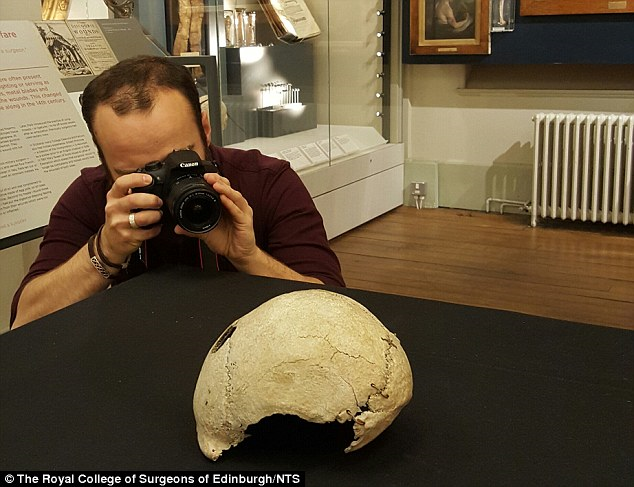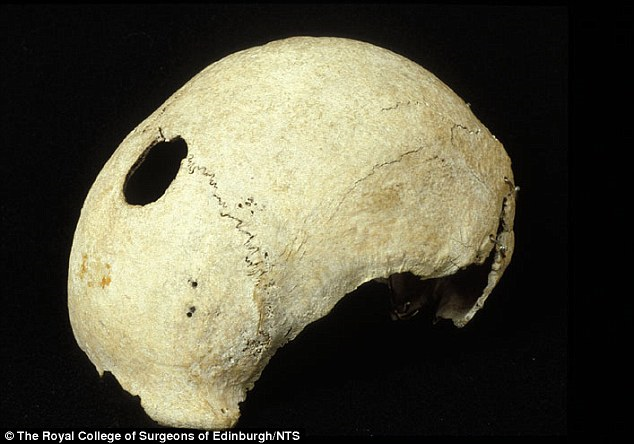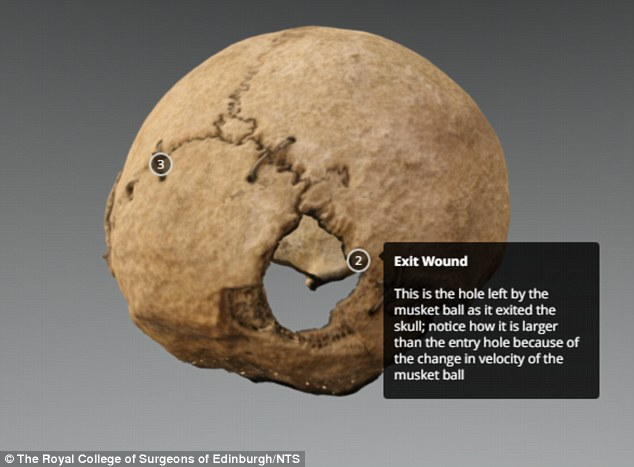Every now and then we have to freshen up on our military history. Why? Because 3D modeling and printing technology is being used to enhance artifact research and produce replicas of weapons used in historic battles. Occasionally it is also used to reproduce found bone fragments — like this skull found at the Battle of Culloden site. This battle was the last confrontation of the Jacobite rising against the British Loyalists — ending in 1746. Now, 3D modeling is being used to indicate more details about the skull, which is thought to belong to a soldier who fought against George II in the House of Hanover fought near Inverness in the Scottish Highlands.
This skull has been in an Edinburgh, Scotland museum since it was purchased in 1825 (see below photo). It was apparently part of a 3,000 item collection purchased from the Scottish surgeon Sir Charles Bell. While the skull has been carefully studied before, 3D modeling technology shines new light on details regarding the battle and that time period in warfare. First, the skull shows “evidence of an entry wound of a projectile just left of centre with a larger exit wound at the back lower right.” Also, the skull reveals that a soldier was probably shot at close quarters by a musket (about 147 ft. away.)
The National Trust for Scotland’s Derek Alexander confirms that it is impossible to know whose skull this is: a Loyalist or a Jacobite? But we do know some things for certain. According to Alexander:
“It could be from someone, head down, looking at the ground as they charge forward, or an individual who has already been wounded and is on their hands and knees or indeed it could be someone hit while focusing on reloading their musket. The skull is a unique example of human remains from Culloden and graphically demonstrates the horrific wounds that would have been suffered by both the Jacobite and Government armies as a result of close quarter musketry.”
Stefan Sagrott is an Archaeology Data Officer for the National Trust of Scotland. Here he describes how new technologies are getting outstanding results when used at cultural heritage sites and for artifact replication and research. For example, photogrammetry, which involves photographing an object from different angles to create a 3D model, has proven quite helpful here (see top photo). Sagrott explains:
“Photogrammetry is a great tool for us, especially because it is low cost and doesn’t require any fancy equipment aside from a decent camera and the processing software… By using it to record cultural heritage, it allows us to open up the past to even more people than ever before. We can take an object which would be too fragile for anyone to handle, photograph it, 3D model it and then make it available online for anyone to see, wherever they are.”
Of course, the 3D models can also be 3D printed and displayed in a manner that does not compromise the original artifact. While it was a losing battle for this particular soldier at Culloden, archaeology and photogrammetry/3D modeling and printing techniques continue to be a win-win situation for all involved! What are your thoughts on how we are able to study history better with 3D technology? discuss in the Scottish Skull & 3D Imaging forum over at 3DPB.com.
Subscribe to Our Email Newsletter
Stay up-to-date on all the latest news from the 3D printing industry and receive information and offers from third party vendors.
You May Also Like
Printing Money Episode 17: Recent 3D Printing Deals, with Alex Kingsbury
Printing Money is back with Episode 17! Our host, NewCap Partners‘ Danny Piper, is joined by Alex Kingsbury for this episode, so you can prepare yourself for smart coverage laced...
Insights from Cantor Fitzgerald on AM’s Q1 2024 Landscape
A recent survey by Cantor Fitzgerald sheds light on the persistent challenges within the additive manufacturing (AM) industry in the first quarter of 2024. Based on responses from 38 industry...
3D Printing Financials: Xometry’s Scaling up and Strong Start to 2024
Xometry (Nasdaq: XMTR) kicked off 2024 with strong results, boosting its marketplace and technology to new heights. Both revenue and gross margin soared, fueled by an expanding global network of...
3D Printing Financials: Desktop Metal Targets Recovery Amid Net Losses and Revenue Downturn
Despite facing a decline in revenue and the persistent challenges of a tight economic climate, Desktop Metal (NYSE: DM) is making strides toward operational efficiency. The first quarter of 2024...



































